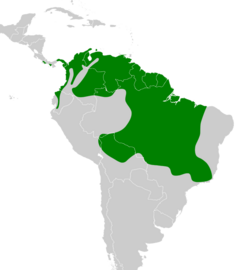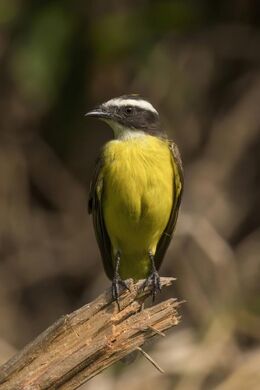Biology:Rusty-margined flycatcher
| Rusty-margined flycatcher | |
|---|---|
| M. c. cayanensis Chagres River, Panama | |
| Scientific classification Error creating thumbnail: Unable to save thumbnail to destination
| |
| Domain: | Eukaryota |
| Kingdom: | Animalia |
| Phylum: | Chordata |
| Class: | Aves |
| Order: | Passeriformes |
| Family: | Tyrannidae |
| Genus: | Myiozetetes |
| Species: | M. cayanensis
|
| Binomial name | |
| Myiozetetes cayanensis (Linnaeus, 1766)
| |

| |
| Synonyms | |
|
Muscicapa cayanensis Linnaeus, 1766 | |
The rusty-margined flycatcher (Myiozetetes cayanensis) is a species of bird in the family Tyrannidae, the tyrant flycatchers.
It is found in northern and central South America in Bolivia, Brazil , Colombia, Ecuador, French Guiana, Guyana, Peru, Suriname, and Venezuela; also eastern Panama. Its natural habitats are subtropical or tropical moist lowland forests and heavily degraded former forest.
Taxonomy
File:Rusty-margined Flycatcher.tif In 1760 the French zoologist Mathurin Jacques Brisson included a description of the rusty-margined flycatcher in his Ornithologie based on a specimen collected in Cayenne in French Guiana. He used the French name Le gobe-mouche de Cayenne and the Latin Muscicapa Cayanensis.[2] Although Brisson coined Latin names, these do not conform to the binomial system and are not recognised by the International Commission on Zoological Nomenclature.[3] When in 1766 the Swedish naturalist Carl Linnaeus updated his Systema Naturae for the twelfth edition, he added 240 species that had been previously described by Brisson.[3] One of these was the rusty-margined flycatcher. Linnaeus included a brief description, used Brisson's Latin name as the binomial name Muscicapa cayanensis and cited Brisson's work.[4] This species is now placed in the genus Myiozetetes that was introduced by the English zoologist Philip Sclater in 1859 .[5] Four subspecies are recognised.[6]
References
- ↑ BirdLife International (2016). "Myiozetetes cayanensis". IUCN Red List of Threatened Species 2016: e.T22700583A93785729. doi:10.2305/IUCN.UK.2016-3.RLTS.T22700583A93785729.en. https://www.iucnredlist.org/species/22700583/93785729. Retrieved 12 November 2021.
- ↑ Brisson, Mathurin Jacques (1760) (in French, Latin). Ornithologie, ou, Méthode contenant la division des oiseaux en ordres, sections, genres, especes & leurs variétés. 2. Paris: Jean-Baptiste Bauche. pp. 404–406, Plate 38 fig 4. https://biodiversitylibrary.org/page/36011716. The two stars (**) at the start of the section indicates that Brisson based his description on the examination of a specimen.
- ↑ 3.0 3.1 Allen, J.A. (1910). "Collation of Brisson's genera of birds with those of Linnaeus". Bulletin of the American Museum of Natural History 28: 317–335.
- ↑ Linnaeus, Carl (1766) (in Latin). Systema naturae : per regna tria natura, secundum classes, ordines, genera, species, cum characteribus, differentiis, synonymis, locis. 1, Part 1 (12th ed.). Holmiae (Stockholm): Laurentii Salvii. p. 327. https://biodiversitylibrary.org/page/42946523.
- ↑ Sclater, Philip Lutley (1859). "Descriptions of new species of the American family Tyrannidae". Proceedings of the Zoological Society of London 27 (1): 40–46 [45, 46]. https://biodiversitylibrary.org/page/44707259.
- ↑ Gill, Frank; Donsker, David, eds (2018). "Old World sparrows, snowfinches, weavers". World Bird List Version 8.2. International Ornithologists' Union. http://www.worldbirdnames.org/bow/weavers/.
Further reading
- Skutch, Alexander F. (1960). "Cayenne flycatcher". Life Histories of Central American Birds II. Pacific Coast Avifauna, Number 34. Berkeley, California: Cooper Ornithological Society. pp. 447–450. https://sora.unm.edu/sites/default/files/journals/pca/pca_034.pdf#page=448.
External links
- Rusty-margined flycatcher videos on the Internet Bird Collection
- Rusty-margined flycatcher photo gallery VIREO
Wikidata ☰ Q1271552 entry
 |



